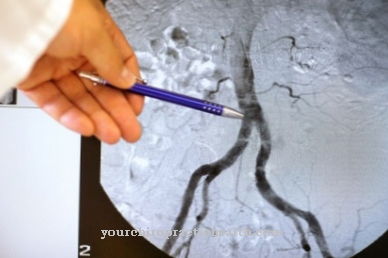Under the term Microangiopathy a pathological change and impairment of the function of the small blood vessels where the exchange of substances with the surrounding body cells takes place is summarized. The capillaries of certain organs such as eyes, kidneys and heart are primarily affected by the disease, with serious health consequences. The main causes of microangiopathy are metabolic disorders, high blood pressure and autoimmune diseases.
What is microangiopathy?

© didesign - stock.adobe.com
The blood vessel system consists of arteries that continue to branch and open into small arterioles. The arterioles continue to branch into capillaries that are invisible to the naked eye. In the continuation of the capillaries, they unite to form alveoli, which in turn connect to form macroscopic veins. As Microangiopathy is a disease and dysfunction of the blood vessels with a microscopically thin cross-section such as arterioles, capillaries and alveoli.
There is no precisely defined demarcation from macroangiopathy, in which the blood vessels with a larger cross section (arteries and veins) are affected. Microangiopathy can affect any body tissue. The pathological changes in the vessels preferably occur, depending on the cause, on the fundus, kidneys, heart, brain and extremities. The walls of the capillaries can be changed in such a way that the necessary diffusion processes, i.e. a bilateral exchange of substances, through the walls with the surrounding tissue cells is only possible to a limited extent or does not occur at all.
The functional restrictions are often due to deposits in the capillary walls, which - comparable to arteriosclerosis - make the capillary walls inelastic and unsuitable for gas and substance exchange. In rare cases, microangiopathies can also be caused by local occlusions of the upstream arterioles and arteries, so that there is no exchange of substances in the capillaries due to the lack of blood flow.
causes
Microangiopathies are usually long-term sequelae of other pre-existing conditions. The most important triggers are arterial hypertension, metabolic diseases such as diabetes mellitus and systemic autoimmune diseases. The arterial high blood pressure is usually itself caused by previous illnesses, which also affect the blood vessel system differently. Chronic stress is probably the most common cause of primary arterial hypertension in which there are no previous organic diseases.
Chronic stress leads to a sympathetic conversion of the metabolism to short-term access to top physical performance such as flight or attack, without the physical potential being ultimately accessed. The stress hormones adrenaline and noradrenaline, released by the sympathetic nervous system, ensure constant vasoconstriction, resulting in increased blood pressure with corresponding effects on the capillaries of the blood vessel system.
Metabolic diseases can change the composition of the capillary membranes in the long term and impair their function. In diabetes mellitus, the retina in the area of the macula, the point of sharpest vision, is usually affected.
Symptoms, ailments & signs
The symptoms and complaints of microangiopathy depend primarily on the organs and tissues affected and the resulting restrictions on their functions. In metabolic disorders caused by diabetes mellitus, when the sugar balance is not artificially stabilized, the retina of the eye is often the first to be affected.
Initially, there is a mostly unnoticed disturbance in the exchange of substances in the retina. In the further course of the disease, the macula and later the entire retina are affected. In Europe and North America, microangiopathy-based diabetic retinopathy is the leading cause of blindness.
Diagnosis & course of disease
Possible diagnostic methods always relate to the organ tissue in which microangiopathy is suspected. While the fundus of the eye can be examined optically non-invasively in the case of retinopathy, a biopsy and a microscopic examination of the tissue samples taken are necessary for a proper examination of the kidneys and liver.
In advanced stages, microangiopathy of the kidneys and heart can lead to renal insufficiency or heart failure. Subcortical arteriosclerotic encephalopathy (SAE) also ultimately arises from a microangiopathy that initially leads to the breakdown of myelin, the myelin sheaths of the neurons in the CNS.
In the advanced stage, motor disorders, urinary incontinence and neuropsychological disorders up to dementia appear. The blood circulation in the terminal vascular system (arterioles, capillaries, venules) can only be observed microscopically in the skin by using laser Doppler fluxmetry and coloring with sodium fluorescein.
Complications
As a rule, the symptoms of microangiopathy depend on the organ affected and can be very different. However, this disease has a very negative impact on the organ and the tissues that it affects. It is not uncommon for diabetes to cause discomfort in the eyes and retina, so that in the worst case the person affected can go completely blind.
Especially in young people, complete blindness can lead to severe psychological complaints or depression and thus severely impair the quality of life. It is not uncommon for the microangiopathy to develop into renal insufficiency. In the worst case, this can cause the person concerned to die and is dependent on dialysis or a donor kidney.
Heart failure can also occur and in extreme cases lead to the patient's death. The treatment of microangiopathy is usually always based on the underlying disease and tries to treat it. However, it cannot be generally predicted whether this will lead to success and a positive course of the disease. In many cases, life expectancy is significantly reduced by microangiopathy.
When should you go to the doctor?
The microangiopathy must always be examined and treated by a doctor. There is no self-healing. If left untreated, the disease can, in the worst case, lead to the death of the patient. The symptoms of microangiopathy depend heavily on the organ affected. Usually, however, the patients suffer from diabetes and continue to have eye problems. The eyesight decreases and it comes to blurred vision or vision. If these complaints occur without a particular reason and, above all, permanently, a doctor should be consulted. Microangiopathy can lead to blindness if symptoms are ignored. Symptoms of the kidneys or the heart also indicate this disease.
The condition can be diagnosed by a general practitioner. For further treatment, however, a visit to other specialists is necessary. In general, it cannot be predicted whether this will lead to a positive course of the disease. The life expectancy of the patient may be limited or reduced by the microangiopathy.
Therapy & Treatment
Efficient treatment is always based on the underlying disease, because microangiopathy is usually the result and not the cause of the underlying disease. First and foremost, diabetes mellitus and primary arterial hypertension (high blood pressure) should be mentioned. Before or in parallel with treatment for retinopathy or renal insufficiency, it should be ensured that the sugar balance is optimally adjusted and that the arterial blood pressure corresponds to the normal values.
In some cases, the microangiopathy is caused by a change in the composition of the blood and, as a result, a change in the flow properties. Here, too, it is advisable to first treat the causes of the change in the blood count. Normally, with the normalization of the flow properties of the blood, the microangiopathy also regresses.
In the case of illness from one of the numerous autoimmune diseases, treatment is very difficult because the autoimmune reactions must be contained with medication and the body should not come into contact with the triggering substances if possible.
You can find your medication here
➔ Drugs for wound treatment and injuriesOutlook & forecast
In general, starting therapy early leads to a favorable prognosis. Doctors can not only relieve the acute symptoms, but also prevent chronic kidney failure. Furthermore, the following aspects favor the prospects: a young age, no significant comorbidities and a reduced number of lesions. If these aspects are not present, there are usually no complications to be expected.
If microangiopathy has already developed, the chances of recovery are unfavorable. Doctors can only try to inhibit or slow down the progress. For this purpose, the blood sugar level in particular is adjusted using suitable therapies. Microangiopathy can be fatal if the outcome is unfavorable. Sometimes people also go blind, which can lead to mental health problems.
A disease always leads to restrictions in everyday life. Patients must be closely monitored. The reduced function of the blood vessels must be countered. Overall, the overall picture is mixed. Sick people often have to cope with a reduced life expectancy. Starting treatment too late will once again reduce the lifespan. However, today's medical possibilities allow a largely symptom-free everyday life. Those who stick to agreed rules significantly reduce their risk.
prevention
Preventive measures to protect against microangiopathy essentially consist in avoiding underlying underlying diseases such as diabetes mellitus and arterial hypertension. If other metabolic diseases are known that can trigger microangiopathy, preventive measures consist in adjusting the metabolic values concerned to the normal values as far as possible. In the presence of an inherited or acquired gene mutation that could trigger autoimmune reactions, there are no direct preventive measures. Typically, such immune system abnormalities are not discovered until symptoms have appeared.
Aftercare
Microangiopathy leads to various complaints and complications, all of which generally have a very negative effect on the quality of life and also on the life expectancy of the person affected. A doctor should be consulted at the first signs and symptoms in order to avert further complications. With this clinical picture, no independent healing can occur. In most cases, microangiopathy leads to various ailments in the internal organs.
Above all, there are metabolic disorders and, furthermore, diabetes. Those affected often suffer from a need for fluids and also from weight loss. In the worst case, if left untreated, complete blindness can occur, which can no longer be treated.
The kidneys and the heart are also affected by the microangiopathy, so that an insufficiency of the heart or the kidneys can occur, which also leads to death. Further treatment depends very much on the cause of the disease, so that a general prediction can usually not be made. In many cases, the life expectancy of the person affected is also reduced.
You can do that yourself
The measures that can be taken by those affected by microangiopathy always depend on the underlying disease.
If the condition is caused by diabetes mellitus, the most important step is a change in lifestyle. If not already done, the person affected must adapt their diet to the disease and do moderate exercise. Overweight people should aim for weight loss, because this is the only way to counteract diabetes mellitus and thus also microangiopathy in the long term. A doctor must optimally adjust the sugar balance and also check the arterial blood pressure.
If the microangiopathy is caused by an autoimmune disease, drug treatment is required. Those affected should primarily take it easy and cure the underlying disease completely. Lifestyle changes are also recommended here, as a strengthened immune system is less prone to serious complications.
People who suffer from microangiopathy require close control by their family doctor. If secondary diseases or serious complications have already developed, a specialist must be consulted. The most important self-help measure is to have the functional impairment of the small blood vessels regularly checked by a doctor and to ensure that the medication is optimally adjusted.


.jpg)





















.jpg)



